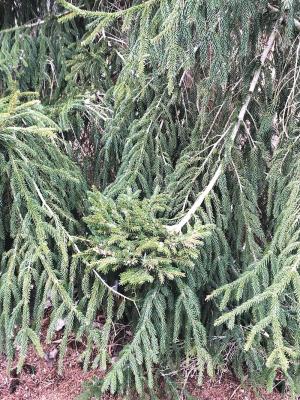2022 - Volume #46, Issue #3, Page #22
[ Sample Stories From This Issue | List of All Stories In This Issue | Print this story
| Read this issue]
New Trees Created From “Witches’ Brooms”
 |
Michigan nurseryman Gary Gee is a “broomer”. He has more than 25 trees in his collection, including Gee Wiz bald cypress, Gee Broom Fraser fir, and Gee Broom dwarf Korean pine. Each is a new cultivar created from witches’ brooms.
Gee Farms is home to 600 acres of shrubs and trees and an arboretum with thousands of conifers and deciduous trees, perennials, and hard-to-find plants.
“Just because you find a witches’ broom and graft it to an understock doesn’t mean it’s a winner,” says Gee. “Not more than 1 out of 10 turn out to be a good, new cultivar.”
Gee has started hundreds of prospects over the years, with most ending up on a burn pile. That doesn’t stop him from looking for more. Each winter he and fellow broomers head into northern Michigan and its Upper Peninsula to look for more.
Gee concentrates mostly on conifers. “But they can be found on pretty much every type of tree,” he says. “It could be a mutant branch tip or the result of a viral disease. If there are more than one in a tree, it is likely a disease. Black spruce is notorious for them.”
The ideal witches’ broom is younger and smaller, perhaps 10 to 12 in. in diameter, suggests Gee. “You can find some that are 3, 4, even 5 ft. in diameter, but we pass on them,” he says. “We’ve tried them and know they won’t turn out. Usually, you can tell by the size, shape and thickness of the witches’ broom how the end product will turn out.”
“We have clippers on extensions that can reach 80 ft. high,” says Gee. “We’ve even shot them off the branch with a gun.”
Once the broom has been collected, Gee seeks out a compatible understock for grafting. Only a 1 or 2-in. piece of the broom is needed.
Gee’s expertise goes well with being a broomer. He is an internationally recognized grafter, grafting almost 20,000 conifers and deciduous plants each year. Norway spruce work with witches’ brooms collected from most types of spruce trees. Two and three-needle brooms go well with two-needle pines and five-needle brooms normally go on white pine.
“Sugar maple is often used as a universal understock for maple brooms,” says Gee. “Europeans often use different understocks than we do in the U.S.”
Hunting witches’ brooms is an international hobby. Gee suggests interested FARM SHOW readers search for witches’ broom groups on Facebook. “There are several groups, including ones for conifers, ginkgo and a grafting group,” says Gee.
Contact: FARM SHOW Followup, Gee Farms, 14928 Bunkerhill Rd., Stockbridge, Mich. 49285 (ph 517-769-6772; geefarms1849@gmail.com; www.geefarms.com).

Click here to download page story appeared in.

Click here to read entire issue
To read the rest of this story, download this issue below or click here to register with your account number.




